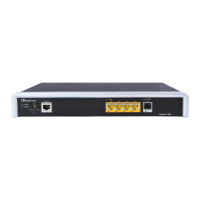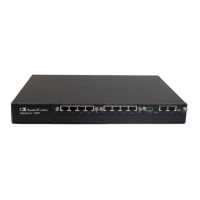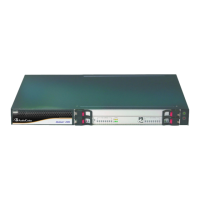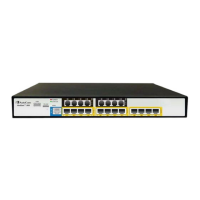Version 7.0 271 Mediant 3000
User's Manual 16. Services
Table 16-8: AD-Based Tel-to-IP Routing Rule Configuration Examples
Index Destination Phone Prefix Destination IP Address
1 PRIVATE: 10.33.45.60
2 PBX: 10.33.45.65
3 OCS: 10.33.45.68
4 MOBILE: 10.33.45.100
5 LDAP_ERR 10.33.45.80
6 * LDAP
7 * 10.33.45.72
The table below shows an example for configuring AD-based SBC routing rules in the IP-
to-IP Routing Table:
Table 16-9: AD-Based SBC IP-to-IP Routing Rule Configuration Examples
Index
Destination Username
Prefix
Destination Type
Destination
Address
1 PRIVATE: Dest Address 10.33.45.60
2 PBX: Dest Address 10.33.45.65
3 OCS: Dest Address 10.33.45.68
4 MOBILE:
Dest Address 10.33.45.10
0
5 LDAP_ERR Dest Address 10.33.45.80
6 * LDAP
7 * Dest Address 10.33.45.72
The configured routing rule example is explained below:
Rule 1: Sends call to private telephone line (at 10.33.45.60) upon successful AD
query result for the private attribute.
Rule 2: Sends call to IP PBX (at 10.33.45.65) upon successful AD query result for the
PBX attribute.
Rule 3: Sends call to Lync client (i.e., Mediation Server at 10.33.45.68) upon
successful AD query result for the Lync attribute.
Rule 4: Sends call to user's mobile phone number (to PSTN through the device's IP
address at 10.33.45.100) upon successful AD query result for the Mobile attribute.
Rule 5: Sends call to IP address of device (10.33.45.80) if AD query failure (e.g., no
response from LDAP server or attribute not found).
Rule 6: Sends query for original destination number of received call to the LDAP
server.
Rule 7: Alternative routing rule that sends the call of original dialed number to IP
destination 10.33.45.72. This rule is applied in any of the following cases
• LDAP functionality is disabled.

